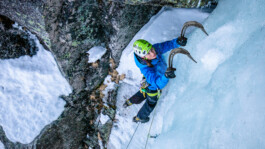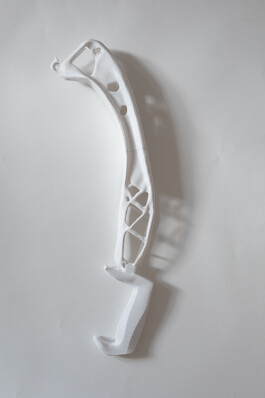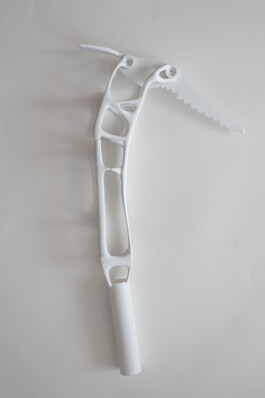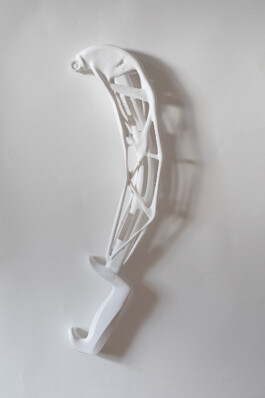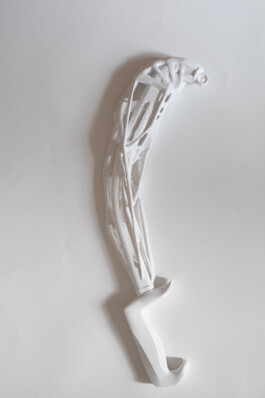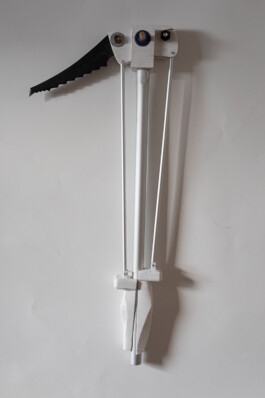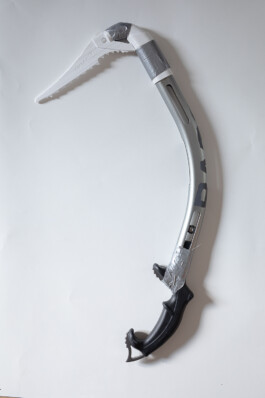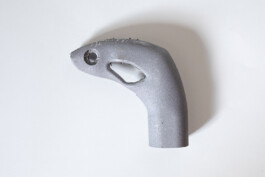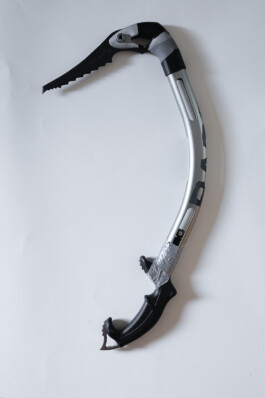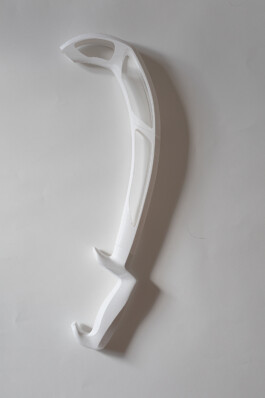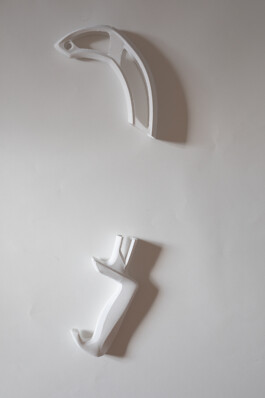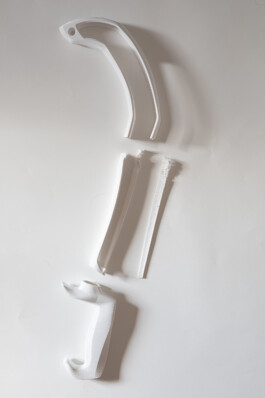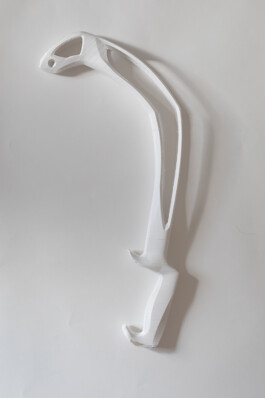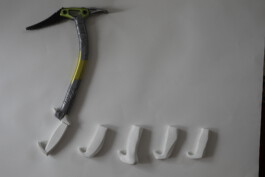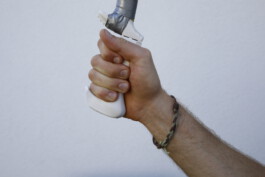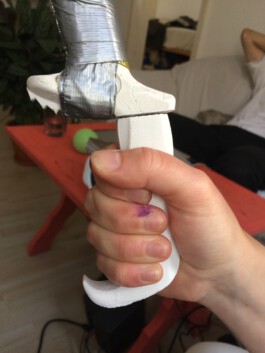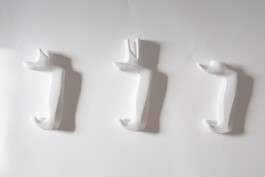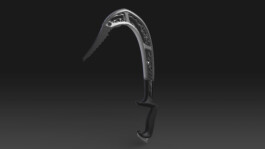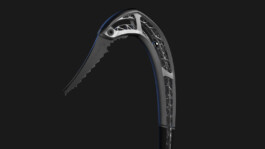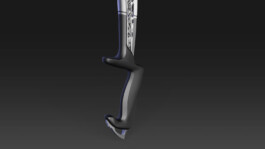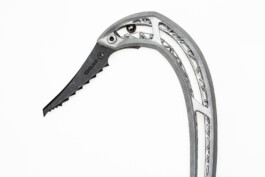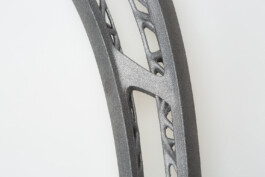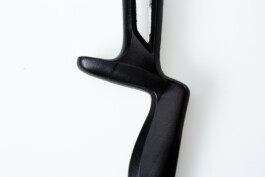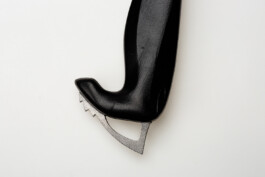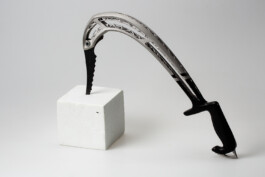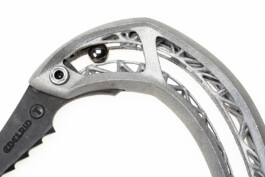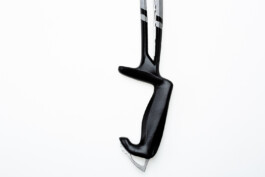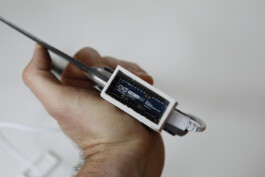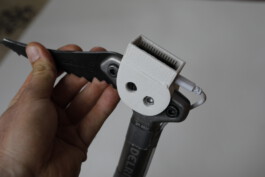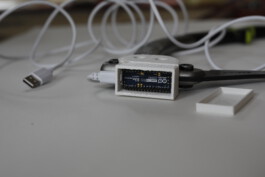Arch
Short version - for long version click here
Arch is an additive manufactured ice axe for ice climbing. It consists of an optimized lightweight structure 3D printed from aluminum. It uses the integration of an innovative acceleration system to overcome the contradiction between the requirements of lightness and the highest possible inertia mass. Additionally, a digital system is integrated to give beginners further confidence while climbing.
Type: Diploma graduation project
2020
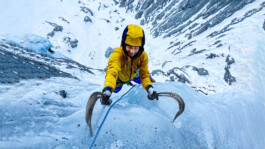
Motivation
In my diploma thesis I investigated the question of how future products, which are produced with additive manufacturing will look like. Thereby the new design freedom should be used for lightweight construction, ergonomics and extended functionality. As an example product I have chosen a technical ice tool for ice climbing. It is a sports gear that fascinates me for a long time. The manageable complexity allowed me to dive deeply into the topic.
In meiner Diplomarbeit bin ich der Frage nachgegangen wie Produkte in Zukunft aussehen werden, die mit additiver Fertigung produziert sind. Dabei soll die neue Formfreiheit für Leichtbau, Ergonomie und erweiterter Funktionalität genutzt werden. Als Beispielprodukt habe ich ein technisches Eisgerät zum Eisklettern gewählt, da es ein Sportgerät ist, welches mich schon lange fasziniert und dessen Komplexität überschaubar ist. Durch die überschaubare Komplexität war es mir möglich sehr tief in das Thema einzutauchen.
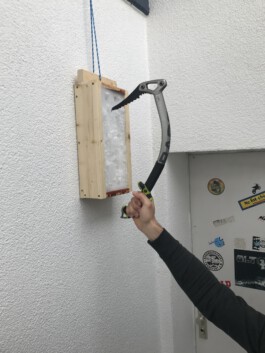
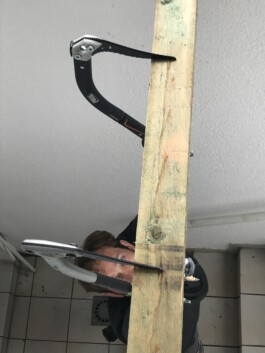
Versuche mit aktuellen Serienprodukten.
Usability experiments with current market products.
Research
In der Research Phase sind vor allem drei Punkte aufgefallen, die für den Verlauf des Projektes interessant waren und die Fokuspoints dominiert haben. Eisgeräte zum Eisklettern haben immer einen Widerspruch in sich. Zum einen ist es wichtig, dass sie leicht sind, da man sie immer den Berg hinauf bewegen muss, zum anderen will man ein möglichst hohes Gewicht haben um genügend Einschlagenergie zu haben. Außerdem lässt sich ein schwereres Gerät präziser schlagen und hat eine höhere Einschlagsenergie.
Eine weitere Erkenntnis aus dem Research war die Position des idealen Schwerpunkts und wovon er abhängt. Nutzer die sehr erfahren sind schlagen das Eisgerät vor allem aus dem Handgelenk, wohingegen Anfänger oder wenig erfahrene Nutzer noch viel aus Schulter und Ellenbogen schlagen. Für einen Schlag aus dem Handgelenk ist die ideale Schwerpunktsposition möglichst nah am Drehpunkt, also am Griff. Je mehr aus Ellenbogen und Schulter geschlagen wird, desto weiter Richtung Kopf muss der Schwerpunkt liegen.
Die dritte Erkenntnis war die Rolle des Vertrauens beim Eisklettern. Das Vertrauen in das Eisgerät ist in den meisten fällen sehr gut, wohingegen das Vertrauen in das Eis und damit auch darin ob der schlag hält, eher schwierig ist. Die Haue sitzt zum Teil nur wenige Millimeter im Eis was zu Unsicherheiten führen kann. Außerdem ist Eis ein sehr spezielles Medium was ständig seine Eigenschaften verändert.
In the research phase, three points in particular stood out as interesting for the course of the project and dominated the focus points. Ice axes for ice climbing always have a conflict. On the one hand it is important that they are light, because you have to carry them up the mountain, on the other hand you want to have the highest possible weight to have enough impact energy. Furthermore, a heavier device can be hit more precisely.
Another key finding from the research was the position of the ideal center of gravity and what it depends on. Users who are very experienced will hit the ice tool mainly from the wrist, whereas beginners or less experienced users hit a lot from shoulder and elbow. For a wrist punch, the ideal center of gravity position is as close as possible to the pivot point which lies close to the grip. The more you hit from your elbow and shoulder, the further the center of gravity moves towards the head.
The third insight was the role of confidence in ice climbing. In most cases, confidence in the ice tool is very good, whereas confidence in the ice and therefore in whether the stroke holds is rather difficult. In some cases, the blade sits only a few millimeters in the ice, which can lead to feelings of insecurity. In addition this is inforced by the fact that ice is a very special medium which constantly changes its properties.
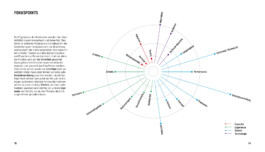
Innovation
Um die Problematik mit dem Gewicht zu lösen, wird eine bewegte Masse eingeführt. Diese wird von der Zentrifugelkraft nach außen beschleunigt und triff mit hoherer Geschwindigkeit auf die Rückseite der Haue. Dort wird der Impuls übertragen und beschleunigt so die Haue.
Die Bewegliche Masse löst auch das Problem mit der Gewichtsverteilung. Bei Beginn des Schlages ist die Kugel nach am Drehpunkt und das System hat eine geringe Massenträgheit. Bewegt sich die Kugel weiter Richtung Kopf, vergrößert sich der Abstand und die Massenträgheit wird größer. Damit Hat das Gerät beim eintreffen auf das Eis eine größere Energie und auch die Verteilung des Gewichts passt sich dem Nutzer an.
To solve the weight problem, a system consisting of a moving mass is introduced. This mass is accelerated outwards by the centrifugal force and hits the back of the blade with high speed. The impulse is transfered and thereby the blade accelerated.
The moving mass also solves the problem of weight distribution. At the beginning of the swing the ball is close to the center of rotation and the system has a low inertia. If the ball moves further towards the head, the distance increases and the mass inertia increases. This means that when the ball hits the ice it has more energy and the distribution of weight adapts to the user.
Gestaltung
In zahlreichen Zwischenschritten wurde die Form des Eisgerätes hinsichtlich Ästhetischen und funktionaler Gesichtspunkte hin optimiert. Dabei wurden neben den digitalen Hilfsmitteln auch einige Modelle mit Hilfe von 3D Druck gebaut. Dabei wurde die Form auf der ästhetischen Seite bis ins kleinste Detail optimiert. Auf der funktionalen Seite wurde neben der Integration des Beschleunigungssystems mit Hilfe einer Ergonomiestudie die Form des Griffes untersucht.
Design
In numerous intermediate steps, the shape of the ice tool was optimized with regard to aesthetic and functional aspects. In addition to digital tools, several models were built using 3D printing. On the aesthetic side, the shape was optimized down to the smallest detail. On the functional side, in addition to the integration of the acceleration system, the shape of the handle was examined with the help of an ergonomics study.
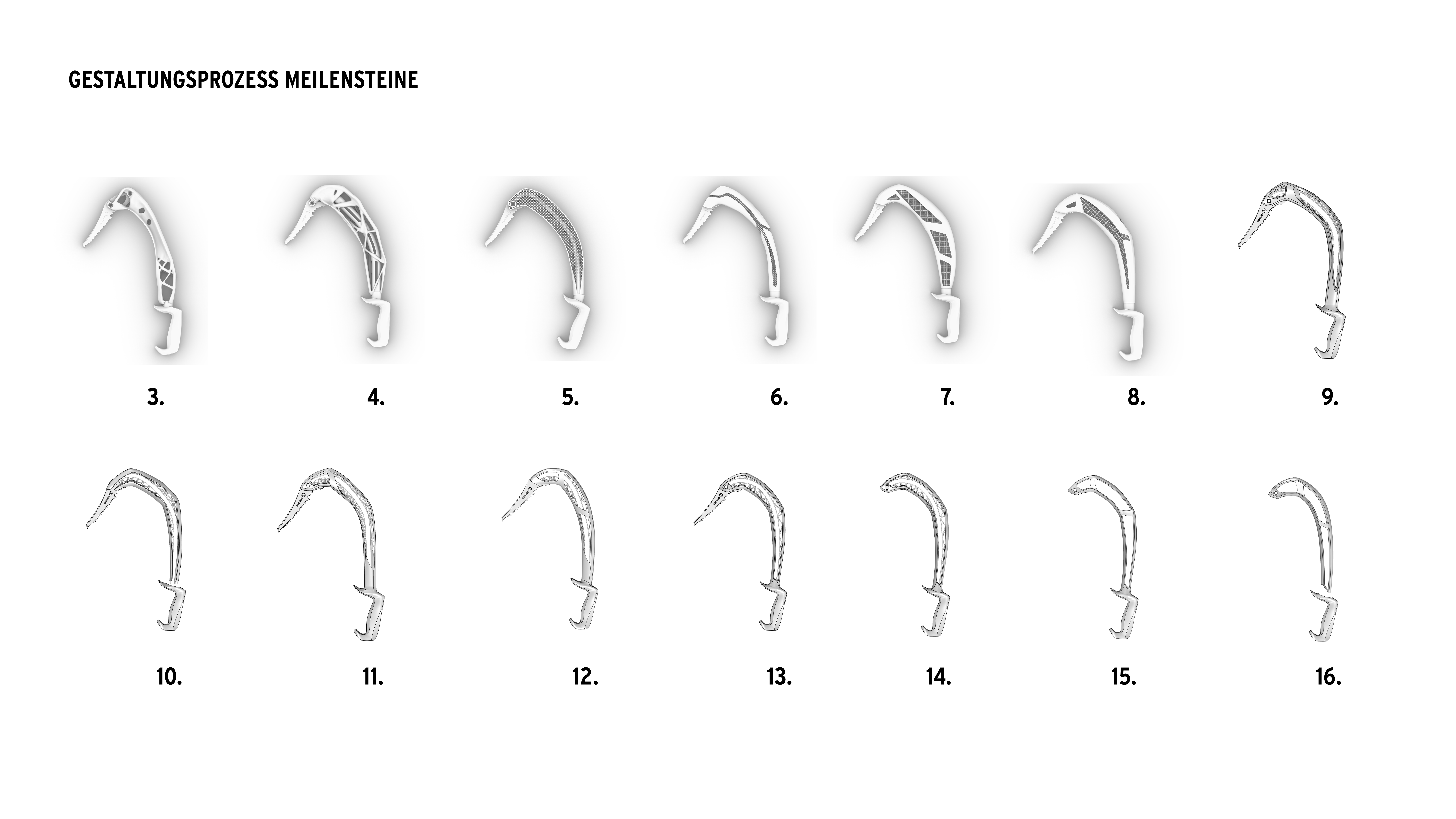
Produkt
Das Ergebnis ist Arch, ein Eisgerät, das Leichtbau optimiert ist. Es wird mit dem SLM Verfahren aus der Aluminiumlegierung ALSi10Mg hergestellt und besteht aus einer inneren Struktur, die von außen von Flächen umgeben ist. Die Flächen dienen zum einen als Schutz, nehmen zusätzlich Kräfte auf und bringen visuell Ruhe in die Form. Formal zieht sich das Thema der Fasen durch den Entwurf. Im Griffbereich, sind sie vorwiegend von funktionaler Bedeutung. Im Schaft- und Kopfbereich dienen die Fasen um das Gesamtprodukt bewusst gestaltet wirken zu lassen. Die Führung der Kugel besteht aus drei Schienen, damit sie nicht herausfallen kann, und ist in die innere Struktur integriert.
Product
The result is Arch, an ice tool optimized for lightweight construction. It is made of the aluminium alloy ALSi10Mg using the SLM process and consists of an inner optimised structure surrounded by surfaces on the outside. The surfaces serve on the one hand as protection, absorb additional forces and bring visual balance to the form. Formally, the theme of chamfers runs through the whole design. In the handle area, these chamfers are mainly of functional importance. In the shaft and head area, the chamfers serve to give the overall product a constant designed appearance. The ball guide consists of three rails to prevent it from falling out and is integrated into the inner structure.
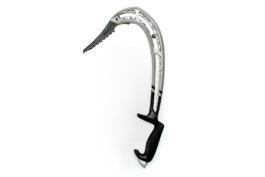
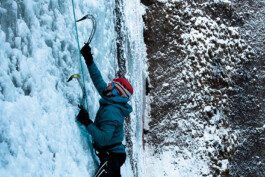
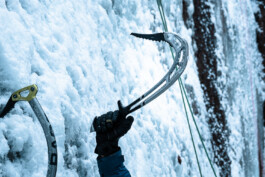
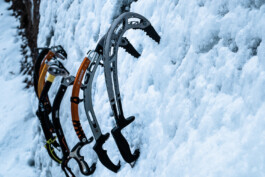
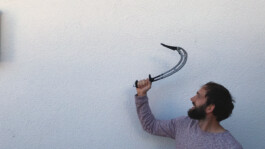
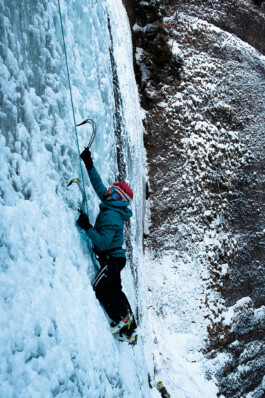
Tini Machine Learning Anwendung
Um dem Kletternden mehr vertrauen in den Schlag und das Eis zu geben, wird mit Beschleunigungs und Kraftsensoren der Schlag analysiert und auf einem Mikrocontroller ausgewertet. Die Ergebnisse werden dann über ein Micro Interface in Form einer Signalleuchte dem Nutzer kommuniziert. Ziel ist es dem Kletternden mehr Vertrauen und eine verbessertes Erlebnis zugeben.
Tini Machine Learning application
To give the climber more confidence in the stroke and the ice, I integrated a system consisting of acceleration and force sensors to analyze the stroke and evaluate it on a microcontroller, by a Tini Machine Learning software application. The results are then communicated to the user via a micro interface in the form of a signal light. The goal is to give the climber more confidence and an enriched experience.
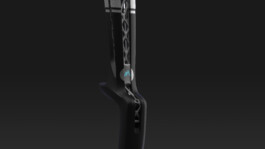
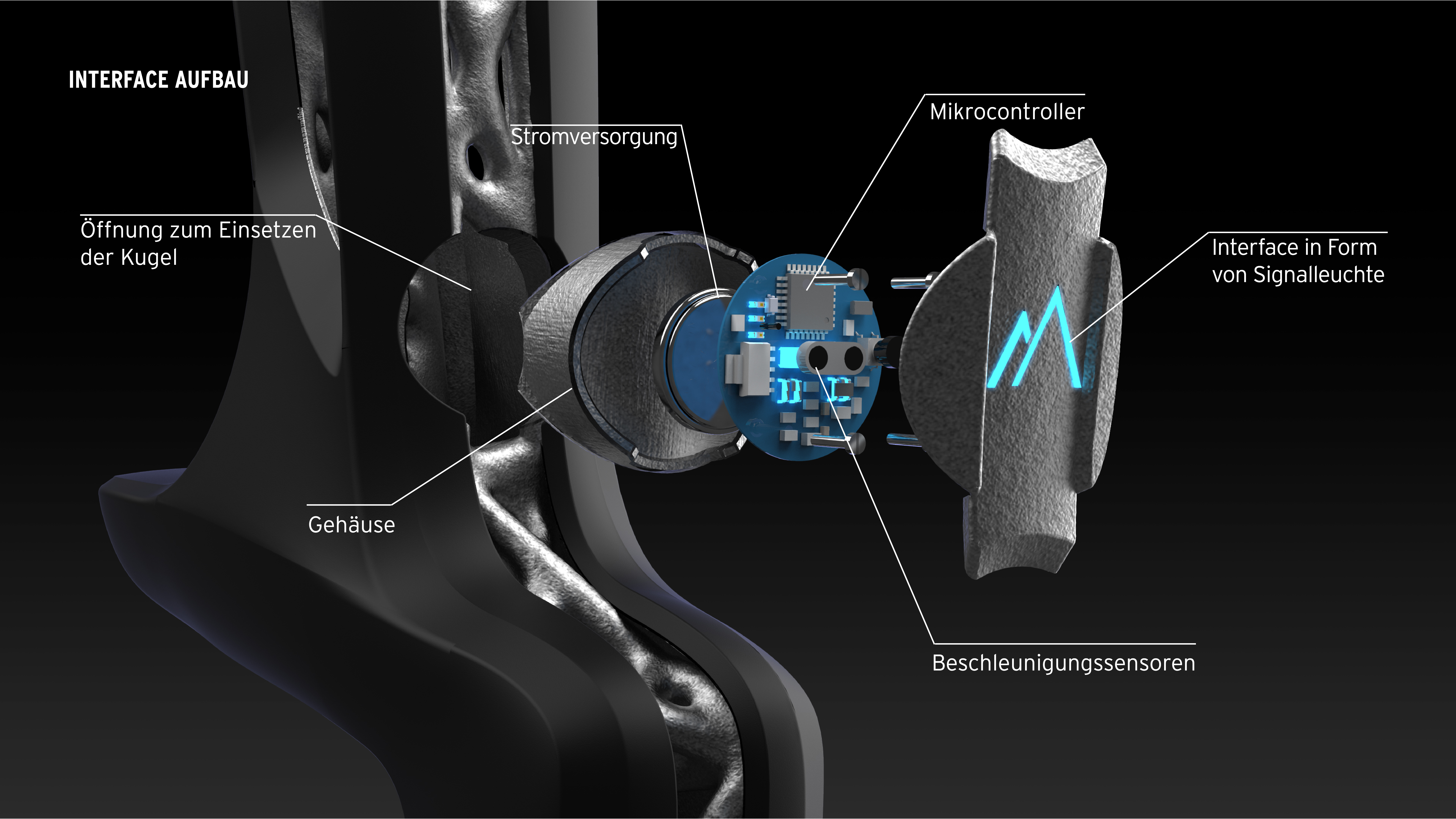
Individualisierung und Nachhaltigkeit
Die Anwendung der additiven Fertigung bietet noch zwei weitere Vorteile. Da der Herstellungspreis unabhängig von der produzierten Stückzahl ist kann das Eisgerät für jeden Nutzer individuell angepasst werden. Dabei ist vor allem die Anpassung des Griffes von Bedeutung da jeder Nutzer unterschiedlich große und breite Hände hat. Die Länge des Schaftes hängt von der Art wie der Nutzer schlägt ab. Wird vermehrt aus dem Handgelenk geschlagen spielt die Länge des Schaftes keine Rolle, wird aus Schulter und Ellenbogen Schwung geholt muss die Schaftlänge auf die Armlänge angepasst werden.
Durch die Anwendung des 3D Drucks wird das Eisgerät über den gesamten Lebenszyklus nachhaltiger. Da nur das Material verwendet wird, was auch tatsächlich gebraucht wird entstehen kaum Abfälle. Außerdem ist das gesamte Gerät aus einem Teil gefertigt und es wird nur die Haue montiert. Dadurch lässt es sich sehr einfach recyceln. Die Gummierung des Griffes kann einfach entfernt werden.
Individualisation and Sustainability
The use of additive manufacturing offers two further advantages. Since the production price is independent of the number of pieces produced, the ice tool can be customized for each user. The adaptation of the handle is of particular importance, as every user has hands of different sizes and widths. The length of the shaft depends on the way the user hits. If the user is swinging from the wrist, the length of the shaft is not of further importance. If the user is swinging from the shoulder and elbow, the length of the shaft has to be adjusted to the length of the arm.
The use of 3D printing makes the ice tool more sustainable over its entire life cycle, as only the material that is actually needed is used and there is hardly any waste. In addition, the entire device is made from one part and only the blade is assembled. This makes it very easy to recycle. The rubber coating on the handle can be easily removed.
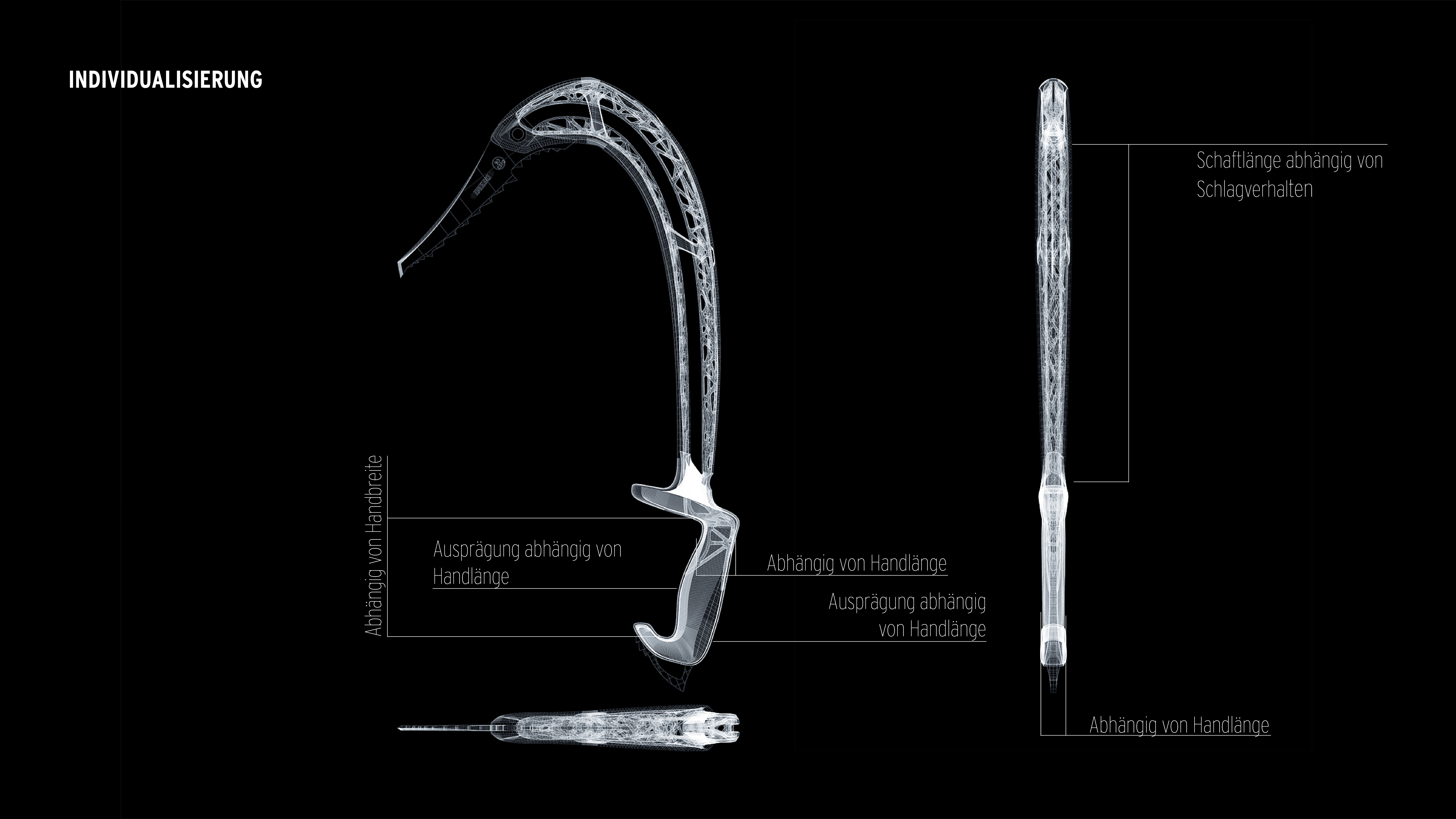
Preise:
Finalist Purmundus Challange

